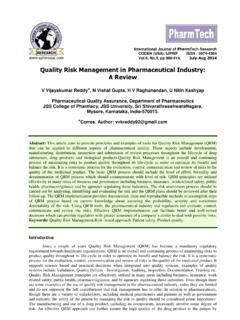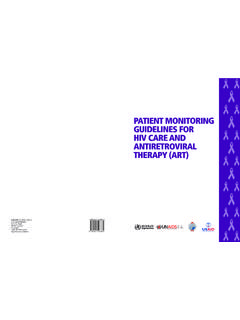Transcription of Pharmacovigilance Systems ANALYSIS in Five …
1 C O M PA R AT I V E Pharmacovigilance Systems A N A LY S I S. in five asian countries n e pa l bangladesh philippines thailand cambodia Comparative ANALYSIS of Pharmacovigilance Systems in five asian countries Jude Nwokike Elisabeth Ludeman Melissa Thumm S E P T E M B E R 2013. This report is made possible through an interagency agreement between the US Food and Drug Administration (FDA). and the US Agency for International Development (USAID). The combined support enabled the Systems for Improved Access to Pharmaceuticals and Services Program to implement the study, under the terms of cooperative agreement number AID-OAA-A-11-00021. The opinion expressed in this report does not necessarily reflect the official position of the FDA, the USAID, or the US Government. The contents are the responsibility of Management Sciences for Health and do not necessarily reflect the views of USAID or the United States Government.
2 About SIAPS. The goal of the Systems for Improved Access to Pharmaceuticals and Services (SIAPS) Program is to assure the availability of quality pharmaceutical products and effective pharmaceutical services to achieve desired health outcomes. Toward this end, the SIAPS result areas include improving governance, building capacity for pharmaceutical management and services, addressing information needed for decision-making in the pharmaceutical sector, strengthening financing strategies and mechanisms to improve access to medicines, and increasing quality pharmaceutical services. Recommended Citation This report may be reproduced if credit is given to SIAPS. Please use the following citation. Systems for Improved Access to Pharmaceuticals and Services (SIAPS) Program. 2013.
3 Comparative ANALYSIS of Pharmacovigilance Systems in five asian countries . Submitted to the US Agency for International Development by the Systems for Improved Access to Pharmaceuticals and Services (SIAPS) Program. Arlington, VA: Management Sciences for Health. Key Words Pharmacovigilance , medicine safety, post-marketing surveillance, quality control, quality assurance, medicine information, medication error, treatment failure, regulatory system Systems for Improved Access to Pharmaceuticals and Services Center for Pharmaceutical Management Management Sciences for Health 4301 North Fairfax Drive, Suite 400. Arlington, VA 22203 USA. Telephone: Fax: E-mail: Website: 2 co m pa r at i v e a n a lys i s o f p h a r maco v i g i l a n c e s ys t e m s i n f i v e a s i a n co u n t r i e s Contents Foreword.
4 7. Acronyms and Abbreviations.. 10. Executive Summary.. 13. Study Methods.. 13. Current State of Pharmaceutical Market in Asia .. 13. Selected Recommendations and Options for Enhancing PV Systems .. 16. Conclusion.. 18. Introduction.. 19. Background on asian Pharmaceutical Market.. 19. Definition and Scope of Pharmacovigilance .. 21. Study Objectives and Methods .. 25. Objectives.. 25. Study Methods.. 25. Review of Regulatory and Pharmacovigilance Systems .. 27. Medication Mishaps Have Catalyzed Medicines Regulation .. 27. Poor Quality Products .. 33. Challenges for Pharmacovigilance Systems in Asia.. 34. Comparative ANALYSIS of Results of Assessment of Pharmacovigilance Systems .. 37. Pharmacovigilance at the National Level.. 37. Governance, Policy, Law, and Regulation.
5 39. Governance .. 39. Policy, Law, and Regulation.. 40. Provisions That Mandate Market Authorization Holders to Conduct Post-Marketing Surveillance .. 40. Systems , Structure, and Stakeholder Coordination .. 45. PV Center or Unit with a Clear Mandate, Structure, Roles, and Responsibilities.. 45. Budget for PV .. 45. Quality Control Lab (or Unit) with Clear Mandate, Structure, and Functions.. 46. National PV Guideline/National Standard Operating Procedures for PV and QC.. 46. Medicines Safety Advisory Committee and Quality Control Advisory Committee.. 47. PV Medicines Information Service.. 47. Core Communication Technologies for PV/Core PV Reference Material in PV Unit/Drug Information Center.. 47. Core PV Topics in Pre-Service Training Curricula .. 47. PV Stakeholder Coordination Mechanism.
6 47. WHO International Drug Monitoring Programme Membership.. 47. Quality Management system for PV and Quality Assurance.. 48. Signal Generation and Data Management .. 51. Systems for Coordination and Collation of PV Data from all Sources within a Country .. 51. Existence of a Form for Reporting Suspected ADRs.. 52. Risk Assessment and Evaluation .. 55. Number of Spontaneous Reports.. 55. co n t e n t s 3. Risk Management and Communication.. 57. Medicine Safety Information Requests Received and Addressed in the Last Year.. 57. Product Quality Surveillance.. 61. PV Capacity at the National Level .. 65. Options for Strengthening Pharmacovigilance at the National Level .. 67. Strengthening Regulatory Policies and Framework.. 67. Ensuring Convergent Regional and International Regulations.
7 67. Improving Information Sharing and Participation in Regional Harmonization Initiatives.. 68. Reforming Organizational Structure to Achieve Integrated Safety Surveillance.. 69. Ensuring Efficient Safety Surveillance and Reduction ofRegulatory Burden.. 69. Improving Funding for PV .. 70. Developing Comprehensive PV Guidelines .. 71. Strengthening Spontaneous Reporting .. 71. Confronting Falsified and Substandard Products.. 73. PV Results in Public Health Programs.. 75. Policy, Law, and Regulation.. 75. Systems , Structure, and Stakeholder Coordination.. 75. Signal Generation and Data Management.. 75. Risk Assessment and Evaluation.. 76. Risk Management and Communication .. 76. PV Capacity at the PHP Level.. 77. Options for Strengthening PV Systems at the PHP Level.. 79.
8 PV Results at the Service Delivery Level.. 81. Policy, Law, and Regulation.. 81. Systems , Structure, Stakeholder Coordination.. 81. Signal Generation and Data Management.. 83. Risk Assessment and Evaluation.. 84. PV Capacity at the Health Facility Level.. 86. Options for Improving PV at the Service Delivery Level (Health Facilities and Community Pharmacies).. 88. PV Results in the Pharmaceutical Industry.. 89. Policy, Law, and Regulation.. 89. Systems , Structure, and Stakeholder Coordination.. 89. Signal Generation and Data Management.. 91. Risk Assessment and Evaluation.. 91. Risk Management and Communication .. 92. Options for Improving PV in Pharmaceutical Industries.. 95. PV Results at the Civil Society Level .. 97. Policy, Law, and Regulation.. 97. Systems , Structure, and Stakeholder Coordination.
9 97. Signal Generation and Data Management.. 98. Risk Assessment and Evaluation.. 98. Risk Management and Communication .. 98. PV Capacity in Civil Societies.. 98. Options for Improving PV in Civil Societies.. 100. Comparison of Performance and Capacity of PV in Selected Asia countries .. 101. Methods.. 101. 4 co m pa r at i v e a n a lys i s o f p h a r maco v i g i l a n c e s ys t e m s i n f i v e a s i a n co u n t r i e s Global and Regional Initiatives for Strengthening Pharmacovigilance Systems in Asia.. 103. Financing Institutions.. 103. Technical Institutions and Programs.. 103. Regional Institutions.. 104. Conclusion.. 105. Annexes .. 107. Annex A. Medication Mishaps and Related Regulatory Forms.. 108. Annex B. Pharmacovigilance Profile .. 110. Annex C. Country Profiles.
10 114. Annex D. Assessment Method .. 124. Annex E. PV Topics in Curriculum.. 125. Annex F. Thailand Health Product Adverse Event Report Form.. 127. Annex G. Glossary .. 128. References.. 131. Index.. 137. List of Tables Table 1. Summary of Pharmaceutical Market in Studied countries .. 20. Table 2. Functions of Select PV Initiatives.. 23. Table 3. WHO-UMC Membership Status.. 29. Table 4. Comparison of Drug Safety Systems Across SRAs .. 31. Table 5. countries of Manufacture of Cambodia Registered Products .. 32. Table 6. Regional Harmonization Initiatives Member countries .. 33. Table 7. PV Governance at the National Level.. 40. Table 8. Content ANALYSIS of PV Regulatory Requirements for the Pharmaceutical Industry in Two countries .. 41. Table 9. Content ANALYSIS of Pharmaceutical Legislation.















